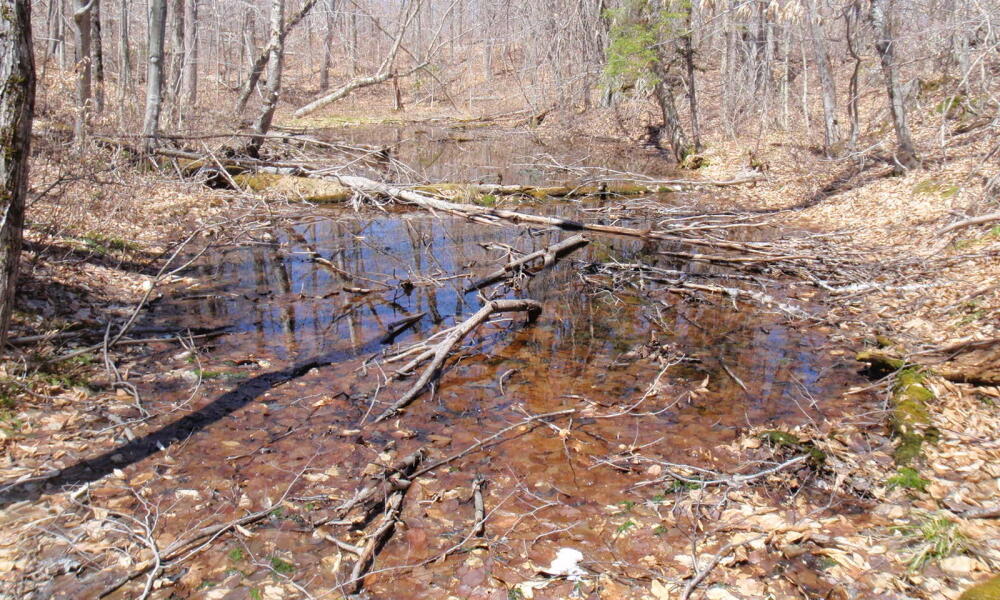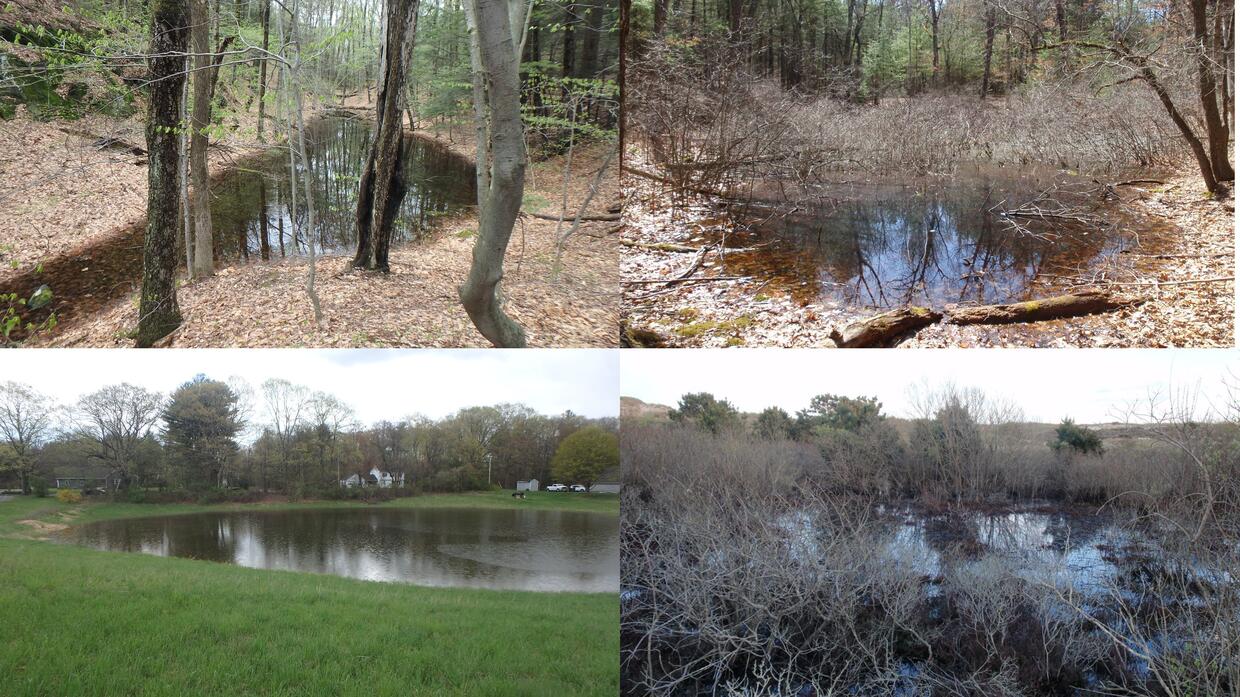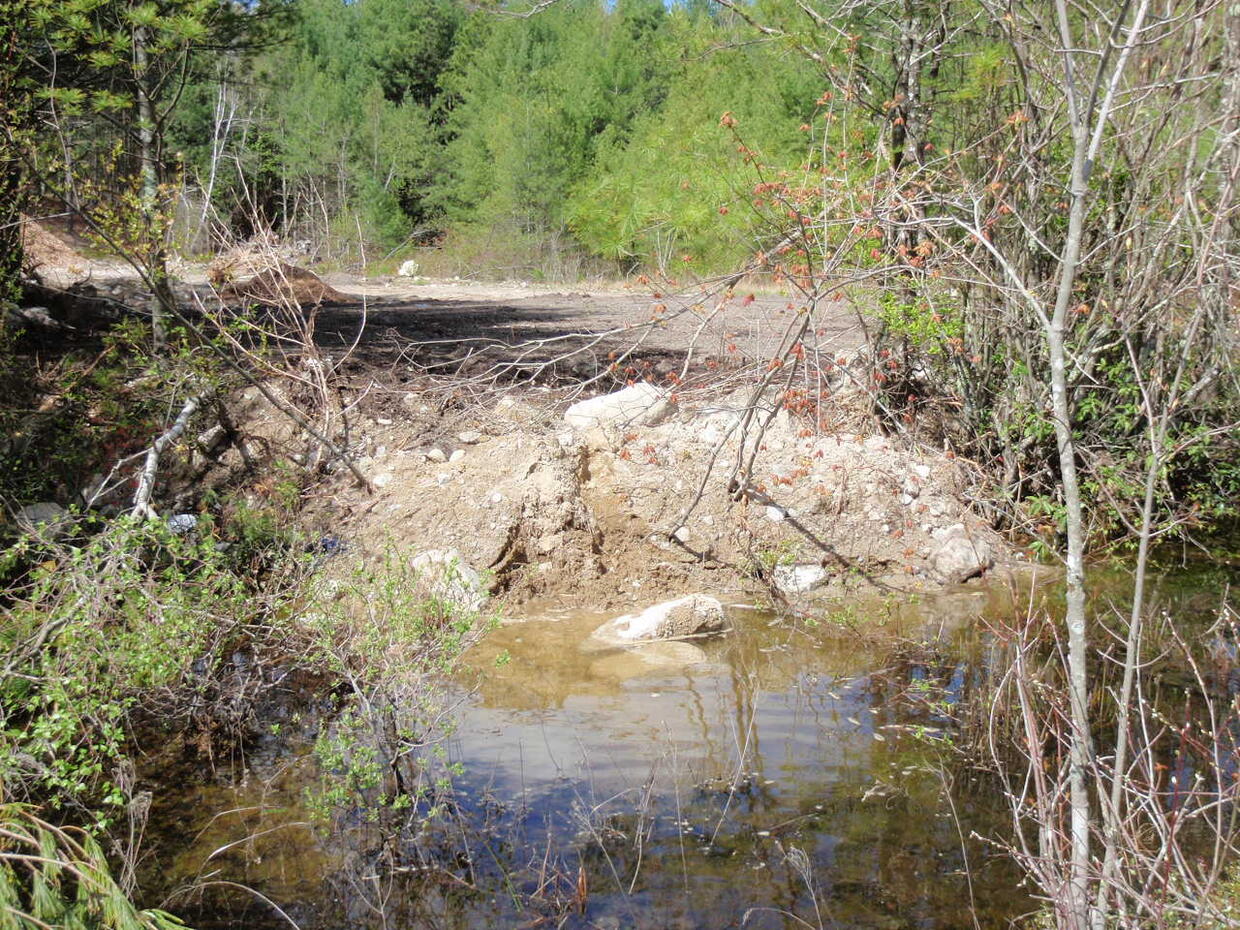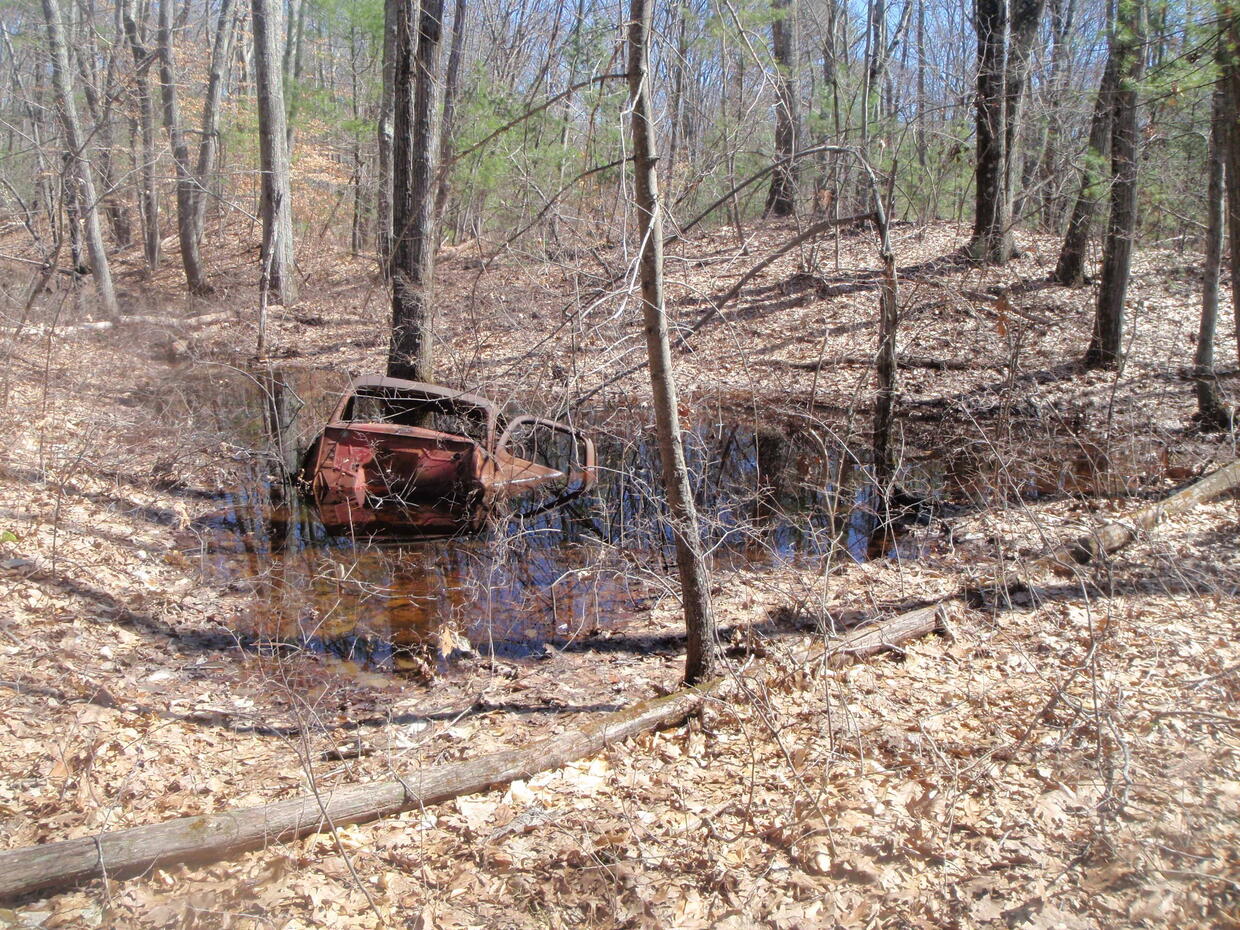Habitat description
Vernal pools are relatively small, shallow, freshwater wetland basins (or, sometimes, sub-basins within broader wetlands) that hold water during parts of the year in response to precipitation and/or rising groundwater. They are unique wildlife habitats, perhaps known best for the amphibians and invertebrate animals that use them to breed and reproduce. In Massachusetts, most vernal pools fill with water during fall, winter, or spring and then remain ponded through spring and into summer. As ambient air temperatures rise and the growing season advances during spring, vernal pools lose water to evaporation, transpiration, or falling water tables, eventually becoming completely dry by the middle or end of summer each year. This wet-dry cycle, described as the vernal pool’s hydroperiod, precludes the establishment of fish populations in the basin and is critical to the reproductive success of many amphibian and invertebrate species that rely on breeding habitats free of fish predators.
Depending on context, setting, hydrological regime, and even personal preference, “vernal pool” may go by alternative names, including but not limited to ephemeral pool, seasonal pool, autumnal pool, temporary pond, or woodland pond. Some pools have a “flashy” hydroperiod, filling with water for only several weeks at a time in response to heavy rain and surface runoff, while others may hold water most of the year or dry out in only some years due to proximity of the water table. Pools may occur in forest, shrubland, grassland, or even coastal dune settings. Vernal pools may be “perched” above bedrock, or they may be groundwater-fed.
For purposes of the Massachusetts State Wildlife Action Plan (SWAP), vernal pools are generally defined as wetland basins that (a) exhibit temporary or non-permanent inundation, (b) are free of fish populations, (c) meet critical life history requirements of native vertebrate and invertebrate Species of Greatest Conservation Need (SGCN), and (d) provide important habitat for other native animal and plant species.
Characteristic natural communities
Vernal pools are generally considered discrete, small-scale habitats embedded within larger communities. They occur within a variety of forested uplands, open lands, land-water interfaces, and broader palustrine habitats. Their occurrences in Massachusetts are characteristic not so much of any particular group or subset of natural communities but, rather, of localized circumstances of post-glacial geology and physical depressions on the landscape. The assemblages of plant species in vernal pools vary widely by the broader habitat types in which they occur and by hydrological regime.
Characteristic plants and animals
Some taxa are considered vernal pool “obligates”, meaning they require vernal pools (or at least fishless portions of wetlands) to complete critical stages of their life cycles (e.g., reproduction). Examples of some common vernal pool obligates in Massachusetts include wood frog (Lithobates sylvaticus), spotted salamander (Ambystoma maculatum), and Eastern fairy shrimp (Eubranchipus vernalis). Some Massachusetts SGCN considered to be vernal pool obligates include Jefferson salamander (Ambystoma jeffersonianum), blue-spotted salamander (Ambystoma laterale), marbled salamander (Ambystoma opacum), Eastern spadefoot (Scaphiopus holbrookii), intricate fairy shrimp (Eubranchipus intricatus), Agassiz’s clam shrimp (Eulimnadia agassizii), and American clam shrimp (Limnadia lenticularis). In fact, Eastern spadefoot and the aforementioned clam shrimp species tend to utilize pools that are so ephemeral that they do not always hold water long enough to meet the regulatory definition of “vernal pool habitat” under the state regulations, thus highlighting the potential vulnerability of certain types of vernal pools in Massachusetts. Many other taxa, although not strictly dependent on vernal pools, heavily utilize them as a resource for certain needs (e.g., feeding, breeding, over-wintering, aestivating, hydrating).
View a complete list of Species of Greatest Conservation Need associated with this habitat.
Associated habitats
Vernal pools may occur in isolation within uplands or as sub-basins within other wetlands, such as forest swamps and seeps, riparian and floodplains, shrub swamps, marshes and wet meadows, calcareous wetlands, and acidic peatlands. The association of “vernal pool habitat” (as defined in the MWPA regulations) with other wetlands is dependent on the presence of standing water with an appropriate inundation period (and isolation from predatory fish) to support reproduction by certain amphibian species. In general, vernal pools are most commonly associated with forests and woodlands, though some do occur in open habitats (e.g., shrublands, grasslands, dune systems).
Ecological processes
Vernal pools occur in a variety of situations, but their original formation is most strongly tied to post-glacial processes involving scouring of bedrock, movement and subsequent deposition of soils, and/or melting of buried ice deposits to form basin depressions on the landscape. Some pools formed where soil deposits of low permeability settled within depressions, others formed where depressions intercepted seasonally high- water tables. Over time, vernal pools also formed in riparian meander scars and in depressions scoured by floodwaters. Some vernal pools have formed from human activities (e.g., sand and gravel extraction, ditching, deliberate pool creation).
Besides direct precipitation, vernal pools receive water via surface runoff, groundwater inputs, or stream overflow, and the vegetation community is influenced mainly by the underlying geology, soils, hydrological regime, and sunlight. Depending on setting, vernal pools may also receive inputs of sediment and organic debris. Like forest succession, vernal pools may transform over time when there is a lack of disturbance. Long-term accumulation of organic material and/or sediment can facilitate conditions for increasingly dense plant growth, such that depth and surface area of standing water gradually decreases. In some cases, vernal pools may eventually succeed to a different type of wetland and cease to provide critical habitat functions for pool-dependent taxa. Conversely, where succession occurs in larger wetlands, vernal pools may form as a result of the wetland basin becoming shallower or fragmented and fish being extirpated.
Threats
Limited public knowledge and education about the importance of vernal pools, combined with deficiencies in regulatory protections and oversight, contribute to the vulnerability of this habitat to a variety of threats in Massachusetts. In general, the relatively small sizes of vernal pools and their periods without water often make them inconspicuous on the landscape, only exacerbating their vulnerabilities. Following is a description of known and potential threats to vernal pools in Massachusetts.
Residential, commercial, and recreation areas
Land development that involves clearing, grading, filling, and/or building-construction and associated landscaping may result in the direct filling and permanent physical loss of vernal pools. Blasting activities near a perched pool can fracture the underlying bedrock or impervious layer, thereby draining the basin and permanently impairing or destroying its hydrologic function. Increased impervious surface in the watershed, particularly in areas adjacent to a pool, may result in altered hydrologic function, reduced water quality, increased nutrient loading and sedimentation, increased salinization, and/or changes in surface water temperatures. Many vernal pool obligates also require the terrestrial habitats surrounding vernal pools to complete their life cycles; vernal pool function can be indirectly disrupted when residential and commercial developments destroy those terrestrial habitats. When development occurs in the immediate vicinity of pools and/or creates physical barriers between pools, the ability of organisms to access and populate those pools is impaired, thus affecting the habitat function of the pools and the metapopulation dynamics of associated SGCN. Development and associated traffic can also lead to direct mortality of amphibians and reptiles, which is especially concerning for SGCN whose reproductive strategies are based on high annual adult survivorship (e.g., Blanding’s turtle, spotted turtle).
Agriculture
Agricultural development involving clearing, grading, and/or filling may result in direct physical loss of vernal pools. Agricultural dumping may physically and/or chemically alter vernal pools. Runoff from agricultural fields may negatively alter vernal pool chemistry and harm associated amphibians via introduction of fertilizers, pesticides, and/or herbicides. Loss of vernal pools to agricultural development does occur occasionally in Massachusetts.
Energy production and mining
Threats from energy production and mining are similar to those resulting from residential, commercial and recreational areas. For instance, energy-production and/or mining activities that involve clearing, grading, and/or filling may result in the direct removal, filling, and permanent physical loss of vernal pools. Blasting activities near a perched pool can fracture the underlying bedrock or impervious layer, thereby draining the basin and permanently impairing or destroying its hydrologic function. In some cases, vernal pool obligates may actually colonize mining sedimentation pools. Those pools are often considered population sinks, as they are unprotected, are reconfigured regularly to fit the needs of the mining operation, and may ultimately be filled, thereby leaving the newly dependent animals without a breeding site.
Transportation, service and security corridors
Existing transportation/service infrastructure may indirectly impact vernal pool habitat by limiting or reducing local biodiversity. Roads, highways, and railways often act as physical barriers to movement and/or sources of adult mortality for organisms (e.g., salamanders, turtles) that use vernal pools and must traverse terrestrial habitat to access them. Roads/highways with high traffic volume also create noise pollution, which may alter breeding behavior (e.g., frog calling) in nearby pools in ways that either impair breeding activity or result in certain tradeoffs that could conceivably reduce reproductive fitness. In addition, transportation corridors are sources of chemical pollution for many vernal pools in Massachusetts, as storm runoff from roads and highways introduces metals, salts, oils, and other compounds to vernal pools, thus altering pool chemistry and, in some cases, impairing or destroying the biological function of the habitat.
Human intrusions and disturbances
An unknown percentage of vernal pools in Massachusetts are impacted by human intrusions and disturbance. The most commonly observed disturbances are dumping, intentional filling, mosquito control, operation of off-road vehicles (ORVs), and biological surveys (both recreational and professional). Dumping activity, as evidenced by the types of old cars and household appliances found in vernal pools, appears to be less substantial now than in decades past. However, dumping of trash, tires, brush, and lawn clippings is an ongoing threat to vernal pools located near roadside pull-offs, trailheads, and suburban yards. Intentional filling of vernal pools with tree limbs, leaves, and other yard waste by landowners attempting to manage surface water on or adjacent to their properties is an occasional problem. An understudied and probably underappreciated threat to vernal pools in Massachusetts is mosquito control, whether conducted unofficially by residential landowners (e.g., via “Bti mosquito dunks”) or formally by state-agency control programs (e.g., via systematic wetlands survey and treatment, aerial insecticide spraying). Reduction of mosquito larvae in vernal pools removes an important food source for amphibian larvae and other natural predators, thereby diminishing habitat quality and biological function. Operation of dirt bikes, all-terrain vehicles, and other vehicles (collectively “off-road vehicles”, or “ORVs”) in or near vernal pool basins is a common occurrence along electric transmission line rights-of-way and in woodlands near human habitation. Chronic physical disturbance, rutting, turbidity, and animal mortality from ORV operation is a threat to vernal pools in many parts of Massachusetts.
Pollution
Vernal pools are vulnerable to nutrient loading and/or chemical contamination when they are adjacent to lawns, golf courses, crop fields, parking lots, roads, gas stations, and other areas where accidental spills or deliberate applications of chemicals occur. Surface runoff from those areas can introduce contaminants to vernal pools, thus altering water chemistry and impairing biological function. The threat of road deicing salts to amphibian reproduction is of especially strong concern in New England. Acidification of vernal pools is a concern for pool-dependent SGCN, especially amphibians (e.g., Jefferson salamander). Low pH (e.g., <4.5) can inhibit embryonic and larval development and survival, thereby reducing reproduction and recruitment.
Climate change and severe weather
A 2024 synthesis of climate data, climate modeling, and climate-related research indicates that temperature, total annual precipitation, and frequency of heavy precipitation events are trending upward in the northeastern United States and are expected to continue to do so into the future. A wetting trend might intuitively suggest potential benefits to vernal pool wildlife by extending the hydroperiod of the average pool, but the timing, frequency, and intensity of precipitation events are important considerations in evaluating the potential impacts of climate change to vernal pool function. However, larger or deeper vernal pools with greater water volumes are likely to be more resistant to climate change and function as climate “refugia” for most pool-dependent amphibians, but shifts in precipitation patterns do threaten the short- and long-term productivity of smaller pools. Climate change could act as a form of habitat degradation by impacting pool functions and consequently reducing the stability of smaller amphibian populations, weakening metapopulations, and facilitating declines.
Conservation actions
Direct management
Restore native vegetation communities in and around vernal pools. Vernal pools with infestations of non-native vegetation should be identified and prioritized for treatment, based on factors such as perceived conservation value to SGCN, protected status, vulnerability to reinfestation, and logistical and financial feasibility of treatment. Treatments can consist of a combination of herbicide application and hand removal, depending on the degree of infestation, plant species involved, and other considerations.
Restore the physical profile of altered and impaired vernal pool basins. Vernal pools that have been impaired by basin alterations such as filling or ditching should be identified and prioritized for potential restoration, depending on the feasibility of restoring adequate hydrological conditions for target SGCN. Restoration work can be achieved by mechanical means or by hand, depending on the scope of the project.
Improve reproductive opportunities for vernal pool SGCN by constructing vernal pool basins. In some situations, construction of vernal pool basins can be used as a management strategy to mitigate prior habitat loss or to improve breeding opportunities for local populations of SGCN that are threatened with other stressors.
Data collection and analysis
Conduct targeted biological surveys of known and potential vernal pools for SGCN. Biological inventory and monitoring of vernal pools is necessary to identify and understand the distribution and abundance of vernal pool SGCN. Data generated by such surveys are critical to establishing and maintaining site-specific regulatory protections for SGCN and to developing effective, long-term conservation plans for the species.
Develop and implement a long-term, statewide vernal pool monitoring program. Long-term monitoring of vernal pool hydrology, chemistry, pathogen loads, and use by associated SGCN would be very helpful in detecting, understanding, and acting on SGCN population trends at local and state scales. Such a program would be especially beneficial in understanding and planning for impacts associated with climate change, emerging infectious disease, pollution, environmental acidification, and habitat loss/fragmentation.
Conduct species-specific research at vernal pools to fill data gaps associated with SGCN life history, habitat requirements, population ecology, sampling techniques, and other subjects. Vernal pools function as population centers for several SGCN and, therefore, are natural sites for studying fundamental aspects of species ecology and improving our knowledge about how to study or monitor populations more effectively. Investigations into population genetics, microhabitat preferences, metapopulation dynamics, and survey efficacy are examples of pool-based research that has helped inform conservation planning and associated actions over the past decade and will continue to do so into the future.
Education and outreach
Promote vernal pool certification in Massachusetts. One of the most effective means of protecting vernal pool basins from direct loss is to have them certified as “vernal pool habitat”. Promotion of the certification program is an effective way to involve the Massachusetts public in “hands-on” stewardship of the environment, and the certification process involves participants in ways that educate them about vernal pool habitats, their functions, and their value to SGCN and local biodiversity. Promotional tools may include website and/or social media development, listserv announcements, and workshops.
Produce and provide educational products, services, and opportunities to the Massachusetts public regarding vernal pool ecology and conservation. Keeping the public knowledgeable about vernal pool ecology and the importance of vernal pools to SGCN and biodiversity is prerequisite to raising awareness of conservation needs and support for action. Providing educational services and opportunities for hands-on experience are key methods to keeping the public interested and active in vernal pool conservation. Together, those actions should help foster public support for vernal pool research, regulatory protections, and conservation initiatives. Products, services, and opportunities may include vernal pool publications, website development, technical support for vernal pool certification, technical support for school studies/programs, coordination of citizen science projects, and public presentations.
Land and water rights acquisition and protection
Develop and maintain a list of vernal pools that should be considered priorities in land protection for SGCN. The BioMap project by MassWildlife and The Nature Conservancy prioritized coarse areas statewide for potential land-protection efforts, and some of those areas were based more finely on occurrences of PVPs. In addition, occurrences of confirmed breeding pools of amphibian SGCN were ranked for relative conservation value and used to prioritize specific vernal pools and their associated uplands for land protection. However, additional work will always be needed to better understand local pool-breeding amphibian and invertebrate populations and, therefore, refine existing rankings of vernal pools for continued land acquisition and protection efforts. Some of the “Data Collection and Analysis” actions described above are designed in part to inform land-protection decisions.
Law enforcement
Continue to implement legal mandates of the Massachusetts Endangered Species Act (M.G.L. c. 131A) and regulations (321 CMR 10.00). MassWildlife's Natural Heritage and Endangered Species Program regulates environmental impacts to vernal pools where they are known to function as habitat for SGCN listed as Endangered, Threatened, or Special Concern pursuant to the Massachusetts Endangered Species Act (hereinafter “MESA-listed SGCN”).
Enforce other laws that protect SGCN associated with vernal pools. Hunting regulations (321 CMR 3.05) prohibit disturbance, harassment, or other taking of SGCN associated with vernal pools.
Law and policy
Develop or update regulations and policies as necessary to address emerging threats. Needs to adopt new regulations and/or policies may arise as knowledge is gained about climate change, emerging infectious disease, animal trade, and other threats to vernal pool ecology and related SGCN.
Planning
Develop and maintain lists of vernal pools that should be considered priorities in future biological surveys for SGCN. Discovery of undocumented populations of vernal pool SGCN is a conservation priority. Additional priorities include identification of all vernal pools currently used by a given population and an evaluation of the relative importance of each pool to the population. Biological survey continues to be a cornerstone of the conservation strategy for vernal pool SGCN, as the data generated are invaluable to informing other types of conservation actions. Identification and prioritization of prospective survey sites is an essential, annual planning activity to maximize survey efficacy.
Develop detailed conservation plans for SGCN associated with vernal pools. Conservation plans are essential blueprints for setting and achieving conservation objectives. Conservation plans should include detailed needs, actions, and schedules specific to each SGCN and include conservation measures for vernal pools that, among other considerations, account for expected impacts of climate change.
Species reintroduction and stocking
Conduct species introduction and/or reintroduction projects with vernal pools as release sites. Translocation of vernal pool SGCN to sites within geographic ranges of historic occurrence is a potential conservation strategy in Massachusetts that is still in an experimental phase. These experimental projects ultimately aim to identify effective ways to reestablish extirpated populations of pool-breeding SGCN. Thus far, amphibian introduction or stocking seems to be a viable option for reestablishing populations where only the organisms have been lost, but the habitat remains (e.g., as might occur with episodic disease outbreaks). Introductions that rely on vernal pool creation, however, need further investigation.
Restoration & management recommendations
The “Direct Management of Natural Resources” subsection of the Conservation Actions section above provides some restoration and management actions to be undertaken or coordinated by MassWildlife and its partners. However, private landowners are also encouraged to be involved with vernal pool management.
Private landowners whose properties contain vernal pools are mainly encouraged to manage their pools passively. Some general measures include minimizing landscaping, avoiding use of fertilizers and pesticides, and leaving vernal pools undisturbed (i.e., keeping dogs out during the spring, not removing fallen branches or leaf litter, not dumping yard waste or refuse in the basin). However, landowners may also help to maintain the habitat quality of vernal pools and their bordering uplands by removing or controlling non-native trees, shrubs, and vines on the property. If a vernal pool is impaired by prior land use practices (e.g., filling or ditching), landowners may seek potential restoration recommendations from the NHESP.
For additional details, please refer to the Vernal Pools Full Version fact sheet.




